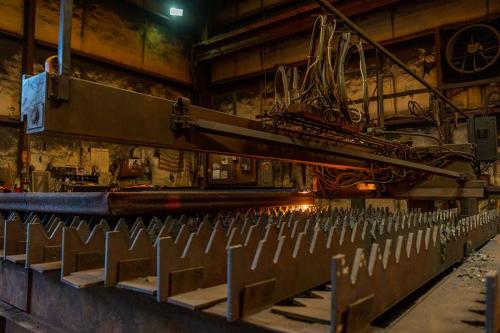What is Heat Treating?
Heat treating refers to a group of thermal, industrial, and metalworking processes that change either the physical or chemical properties of a material. The heat treatment process affects the structure of the material being heated. Most carbon steels and carbon steel alloys can be heat treated to improve qualities like tensile and yield strength. Some specific heat treatments of metals include annealing, normalizing, hardening, and quench & tempering.
Annealing
Annealing is a heat treating process specifically used to increase the ductility and reduce the hardness of a material. During the process, the manufacturer heats the metal and then allows it to cool slowly. This process helps to remove internal stresses making the material easier to work. Certain metals are annealed to increase the electrical conductivity of the materiall. It is an important process in maintaining ductility and reducing hardness after cold working.
Normalizing
Normalizing is another heat treatment of metals, often used when producing steel and steel products. During this process, the material being treated is heated to a predetermined temperature and then held at that temperature for a certain amount of time (usually between 10 to 20 minutes). The purpose of the normalizing process includes removing structural irregularities or impurities, improving ductility, reducing hardness, increasing toughness, relieving internal stresses, and increasing machinability.
Hardening
Hardening is a metallurgical metalworking process used to increase the hardness of metal, particularly steel. This process is usually carried out on finished products and not raw materials. The process is often done on machined parts since hardening a whole block of steel is not economical. Hardened steel is also more difficult to machine, resulting in shorter lifespans of tools and attachments. The hardness of a metal is proportional to the uniaxial yield stress at the location of imposed strain. Harder metals have a higher resistance to plastic deformation, therefore, may be better to use during certain processing procedures.
Quenching and tempering
Quenched and tempered steel is an abrasion-resistant steel that is high in strength, fabrication qualities, and mechanical properties. Production involves heating materials to a certain temperature, coupled with specific cooling speeds and methods. This "quenching" process immediately cools the heated material in water, oil, and forced air or inert gasses such as nitrogen. These two processes result in harder and tougher finished products.
What is Heat Treating in the Steel Industry?
Heat treating is a fundamental process in the steel industry that involves heating and cooling metals in a controlled way to alter their physical and mechanical properties without changing their shapes. It plays a critical role in optimizing the performance, durability, and machinability of steel used across a wide range of industries, from automotive and aerospace to construction and manufacturing.
The Purpose of Heat Treating
Steel, by its nature, can exhibit a wide range of properties depending on its internal structure, or microstructure. Heat treating is used to:
-
Increase strength and hardness
-
Improve ductility and toughness
-
Enhance wear and corrosion resistance
-
Relieve internal stresses
-
Prepare steel for further processing (like machining or forming)
These transformations are essential for tailoring steel to meet specific performance requirements in real-world applications.
Common Heat Treating Processes
Several different heat treating processes are used depending on the desired outcome. The most common include:
1. Annealing
Annealing involves heating steel to a specific temperature and then slowly cooling it. This process softens the steel, increases ductility, and relieves internal stresses. It's commonly used to make steel easier to machine or form.
2. Normalizing
This process heats the steel above its critical temperature and then cools it in air. Normalizing refines the grain structure and improves toughness and strength while ensuring uniformity in the material.
3. Hardening
Hardening involves heating steel to a high temperature followed by rapid cooling, typically in water or oil (quenching). This traps carbon in the crystal structure, making the steel much harder but also more brittle.
4. Tempering
After hardening, steel is often too brittle for practical use. Tempering is a secondary process where the hardened steel is reheated to a lower temperature and then cooled. This reduces brittleness while maintaining a good level of hardness and strength.
5. Case Hardening (Carburizing/Nitriding)
This process is used to harden only the outer surface (or "case") of a steel component while maintaining a softer, tougher core. It's ideal for parts like gears or shafts that need wear resistance on the surface but shock resistance internally.
Importance of Heat Treating in Industry
Heat treating enhances the performance of steel components by improving mechanical properties in line with application requirements. For example:
-
Automotive parts like gears, crankshafts, and axles rely on precise heat treating for strength and durability.
-
Tool manufacturing uses hardening and tempering to produce cutting tools that retain sharp edges.
-
Construction components are often normalized or annealed to handle load-bearing stress.
Heat treating is both an art and a science. It requires careful control of time, temperature, atmosphere, and cooling rate to achieve the desired steel properties. As technologies evolve, so do heat treating techniques, ensuring that steel continues to meet the increasingly demanding needs of modern industry.

